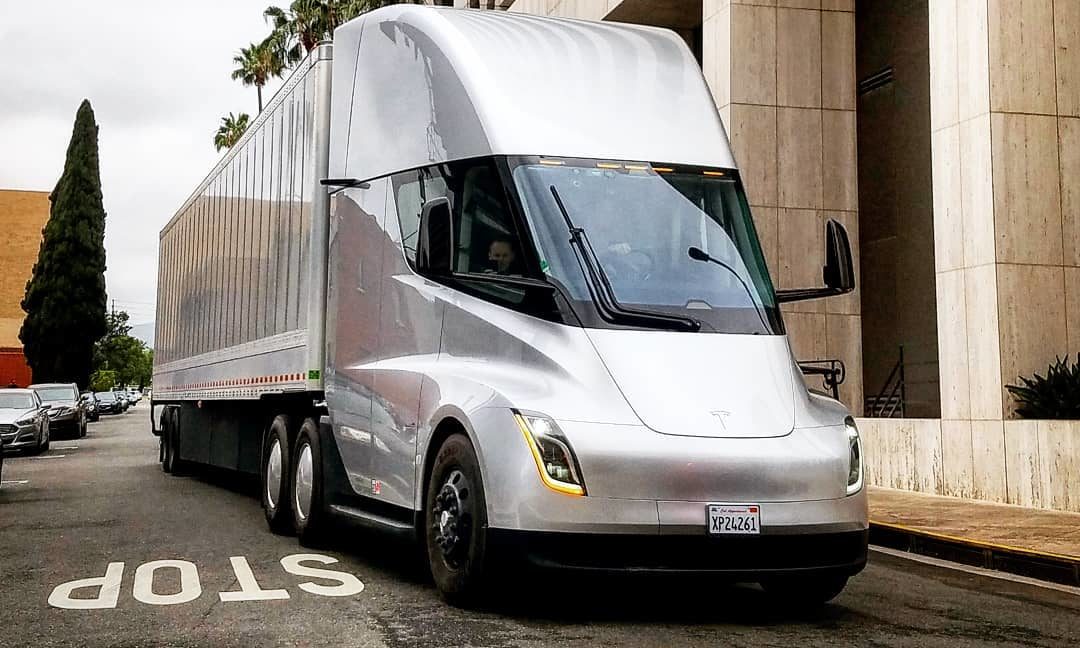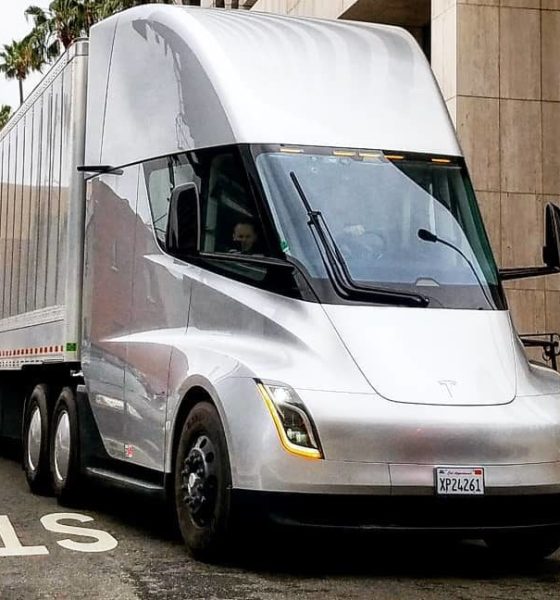

News
Tesla Semi truck production would showcase lessons gained from Model 3
Being the electric car maker’s first entry into the trucking industry, the stakes are high for the Tesla Semi. Just like the Model 3, Tesla could revolutionize the trucking industry if the Semi proves to be a success. The company is aiming to start production of the Semi sometime in 2019 — a target that exhibits Elon Musk’s tendency to adopt aggressive manufacturing timelines. That said, if Tesla’s progress in the Model 3 ramp is any indication, there is a good chance that the Semi could be Tesla’s first vehicle to not run into major problems when it starts production.
Tesla is no stranger to missed production deadlines. In 2007, Tesla announced that it has plans to build 10,000 of the then-mythical Model S sedan annually starting in 2009. Production was ultimately delayed, and the vehicle was introduced in June 2012. The Model X experienced an even more significant delay, with deliveries starting on September 2015 instead of its initially planned early 2014 release. Tesla’s latest vehicle, the Model 3, has experienced delays as well — an ordeal that CEO Elon Musk aptly dubbed as “production hell.” When the handover of the first 30 Model 3 was held last year, Musk announced that Tesla is aiming to produce 5,000 units of the electric sedan a week by the end of 2017. Tesla was only able to hit that target at the end of Q2 2018.
Considering Tesla’s history and reputation for delays, does this mean that the Semi would follow the same fate? Most likely not. On the contrary, the Semi might very well be the first Tesla vehicle that would not experience a delay as bad as its predecessors. Tesla might miss its 2019 target for the truck given that the timeline was announced by a very optimistic Elon Musk, but once manufacturing begins, there is a good possibility that the Semi would not take the company to “production hell” like the Model 3.
When Elon Musk unveiled the Semi last November, he pitched the vehicle as an electric truck that can disrupt the trucking industry. With stunning performance specs such as a 0-60 mph time in 5 seconds flat, a capability to haul 80,000 lbs of cargo, and a range of 500 miles per charge for the Long Range version, the Semi is a serious long-hauler. These impressive specs aside, one thing that made the Semi quite remarkable was the fact that it shared components with the Model 3, from its four electric motors to the two touchscreens on the driver’s console. A video of the Semi shared earlier this year on YouTube even showcased how the truck features an air vent similar to the Model 3.
Tesla is not done with the Semi either. As testing of the vehicle continues, Tesla is rolling out improvements to the truck’s design. Back in May, Elon Musk stated that the Semi’s range would be closer to 600 miles per charge. During the Q2 earnings call, Elon Musk also teased a new battery module “that’s actually lighter, better, (and) cheaper.” These new modules are expected to start production sometime in Q1 2019, which could result in vehicles being lighter and having more range — advantages that are pertinent for the electric long-hauler.
Tesla’s production ramp for the Model 3 proved to be a classic tale of trial and error, with a dash of automation-driven hubris thrown in. Over the past year, the company learned a lot of lessons as it evolved from an upstart automaker into a more mature car company. When Tesla starts the Semi’s production, there’s a good chance that it would no longer be a company that adopts unrealistic release timelines. Instead, it would be an automaker that has gained experience over years of missed deadlines. The fact that the Semi shares components with the electric sedan would be a given plus, but the real boost in the manufacturing of the electric truck would likely be caused the expertise that Tesla gained when it tackled the challenge of the Model 3 ramp.
The market for the Tesla Semi is vast, and so far, reactions from the market are encouraging. During the company’s Q1 2018 earnings call, Elon Musk and CTO JB Straubel noted that Tesla has around 2,000 reservations for the vehicle. Tesla has also acquired orders from companies such as PepsiCo, FedEx, and UPS in the United States and Bee’ah from the United Arab Emirates, to name a few.

Elon Musk
Elon Musk and Tesla AI Director share insights after empty driver seat Robotaxi rides
The executives’ unoccupied tests hint at the rapid progress of Tesla’s unsupervised Robotaxi efforts.

Tesla CEO Elon Musk and AI Director Ashok Elluswamy celebrated Christmas Eve by sharing personal experiences with Robotaxi vehicles that had no safety monitor or occupant in the driver’s seat. Musk described the system’s “perfect driving” around Austin, while Elluswamy posted video from the back seat, calling it “an amazing experience.”
The executives’ unoccupied tests hint at the rapid progress of Tesla’s unsupervised Robotaxi efforts.
Elon and Ashok’s firsthand Robotaxi insights
Prior to Musk and the Tesla AI Director’s posts, sightings of unmanned Teslas navigating public roads were widely shared on social media. One such vehicle was spotted in Austin, Texas, which Elon Musk acknowleged by stating that “Testing is underway with no occupants in the car.”
Based on his Christmas Eve post, Musk seemed to have tested an unmanned Tesla himself. “A Tesla with no safety monitor in the car and me sitting in the passenger seat took me all around Austin on Sunday with perfect driving,” Musk wrote in his post.
Elluswamy responded with a 2-minute video showing himself in the rear of an unmanned Tesla. The video featured the vehicle’s empty front seats, as well as its smooth handling through real-world traffic. He captioned his video with the words, “It’s an amazing experience!”
Towards Unsupervised operations
During an xAI Hackathon earlier this month, Elon Musk mentioned that Tesla owed be removing Safety Monitors from its Robotaxis in Austin in just three weeks. “Unsupervised is pretty much solved at this point. So there will be Tesla Robotaxis operating in Austin with no one in them. Not even anyone in the passenger seat in about three weeks,” he said. Musk echoed similar estimates at the 2025 Annual Shareholder Meeting and the Q3 2025 earnings call.
Considering the insights that were posted Musk and Elluswamy, it does appear that Tesla is working hard towards operating its Robotaxis with no safety monitors. This is quite impressive considering that the service was launched just earlier this year.
Elon Musk
Starlink passes 9 million active customers just weeks after hitting 8 million
The milestone highlights the accelerating growth of Starlink, which has now been adding over 20,000 new users per day.

SpaceX’s Starlink satellite internet service has continued its rapid global expansion, surpassing 9 million active customers just weeks after crossing the 8 million mark.
The milestone highlights the accelerating growth of Starlink, which has now been adding over 20,000 new users per day.
9 million customers
In a post on X, SpaceX stated that Starlink now serves over 9 million active users across 155 countries, territories, and markets. The company reached 8 million customers in early November, meaning it added roughly 1 million subscribers in under seven weeks, or about 21,275 new users on average per day.
“Starlink is connecting more than 9M active customers with high-speed internet across 155 countries, territories, and many other markets,” Starlink wrote in a post on its official X account. SpaceX President Gwynne Shotwell also celebrated the milestone on X. “A huge thank you to all of our customers and congrats to the Starlink team for such an incredible product,” she wrote.
That growth rate reflects both rising demand for broadband in underserved regions and Starlink’s expanding satellite constellation, which now includes more than 9,000 low-Earth-orbit satellites designed to deliver high-speed, low-latency internet worldwide.
Starlink’s momentum
Starlink’s momentum has been building up. SpaceX reported 4.6 million Starlink customers in December 2024, followed by 7 million by August 2025, and 8 million customers in November. Independent data also suggests Starlink usage is rising sharply, with Cloudflare reporting that global web traffic from Starlink users more than doubled in 2025, as noted in an Insider report.
Starlink’s momentum is increasingly tied to SpaceX’s broader financial outlook. Elon Musk has said the satellite network is “by far” the company’s largest revenue driver, and reports suggest SpaceX may be positioning itself for an initial public offering as soon as next year, with valuations estimated as high as $1.5 trillion. Musk has also suggested in the past that Starlink could have its own IPO in the future.
News
NVIDIA Director of Robotics: Tesla FSD v14 is the first AI to pass the “Physical Turing Test”
After testing FSD v14, Fan stated that his experience with FSD felt magical at first, but it soon started to feel like a routine.

NVIDIA Director of Robotics Jim Fan has praised Tesla’s Full Self-Driving (Supervised) v14 as the first AI to pass what he described as a “Physical Turing Test.”
After testing FSD v14, Fan stated that his experience with FSD felt magical at first, but it soon started to feel like a routine. And just like smartphones today, removing it now would “actively hurt.”
Jim Fan’s hands-on FSD v14 impressions
Fan, a leading researcher in embodied AI who is currently solving Physical AI at NVIDIA and spearheading the company’s Project GR00T initiative, noted that he actually was late to the Tesla game. He was, however, one of the first to try out FSD v14.
“I was very late to own a Tesla but among the earliest to try out FSD v14. It’s perhaps the first time I experience an AI that passes the Physical Turing Test: after a long day at work, you press a button, lay back, and couldn’t tell if a neural net or a human drove you home,” Fan wrote in a post on X.
Fan added: “Despite knowing exactly how robot learning works, I still find it magical watching the steering wheel turn by itself. First it feels surreal, next it becomes routine. Then, like the smartphone, taking it away actively hurts. This is how humanity gets rewired and glued to god-like technologies.”
The Physical Turing Test
The original Turing Test was conceived by Alan Turing in 1950, and it was aimed at determining if a machine could exhibit behavior that is equivalent to or indistinguishable from a human. By focusing on text-based conversations, the original Turing Test set a high bar for natural language processing and machine learning.
This test has been passed by today’s large language models. However, the capability to converse in a humanlike manner is a completely different challenge from performing real-world problem-solving or physical interactions. Thus, Fan introduced the Physical Turing Test, which challenges AI systems to demonstrate intelligence through physical actions.
Based on Fan’s comments, Tesla has demonstrated these intelligent physical actions with FSD v14. Elon Musk agreed with the NVIDIA executive, stating in a post on X that with FSD v14, “you can sense the sentience maturing.” Musk also praised Tesla AI, calling it the best “real-world AI” today.








